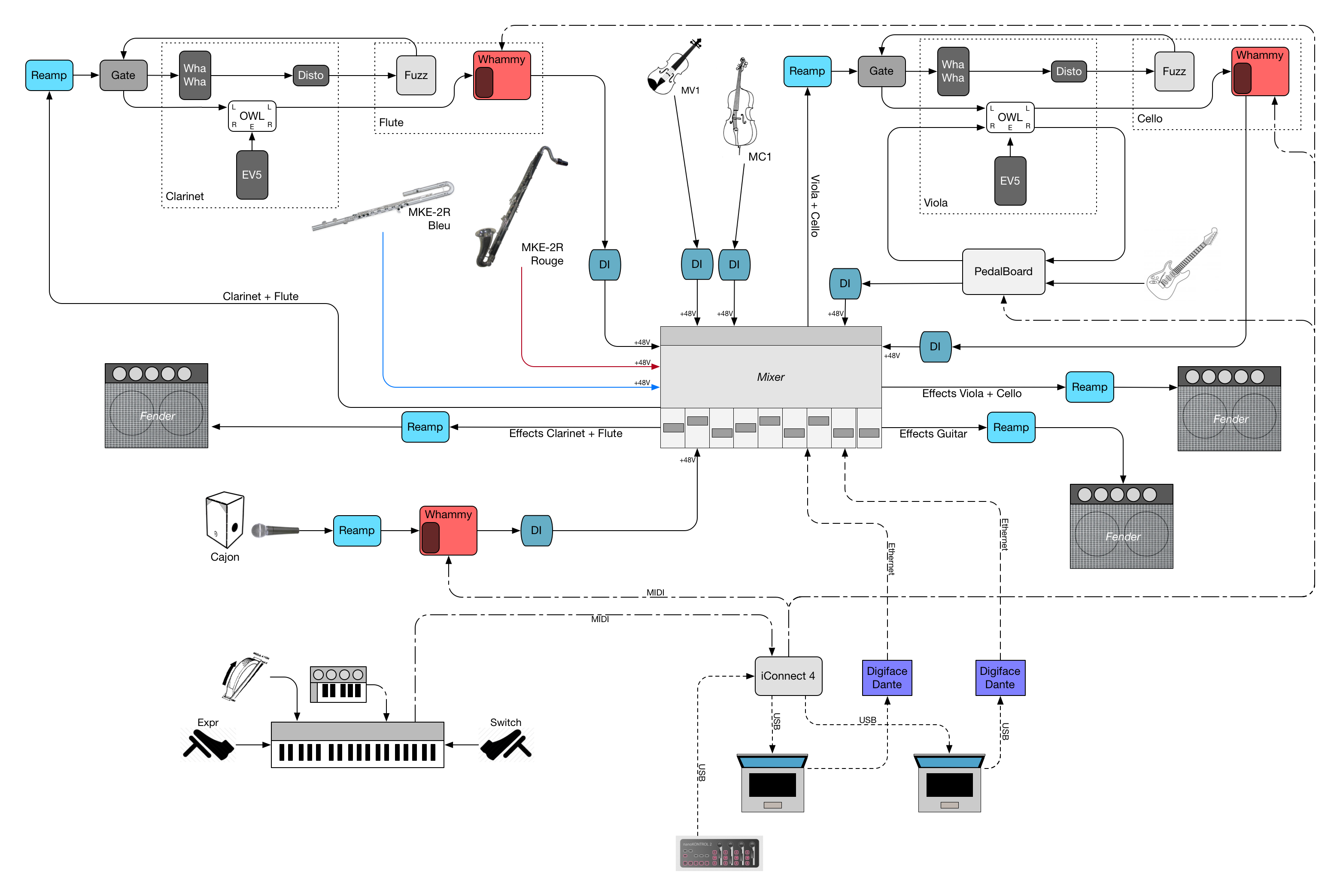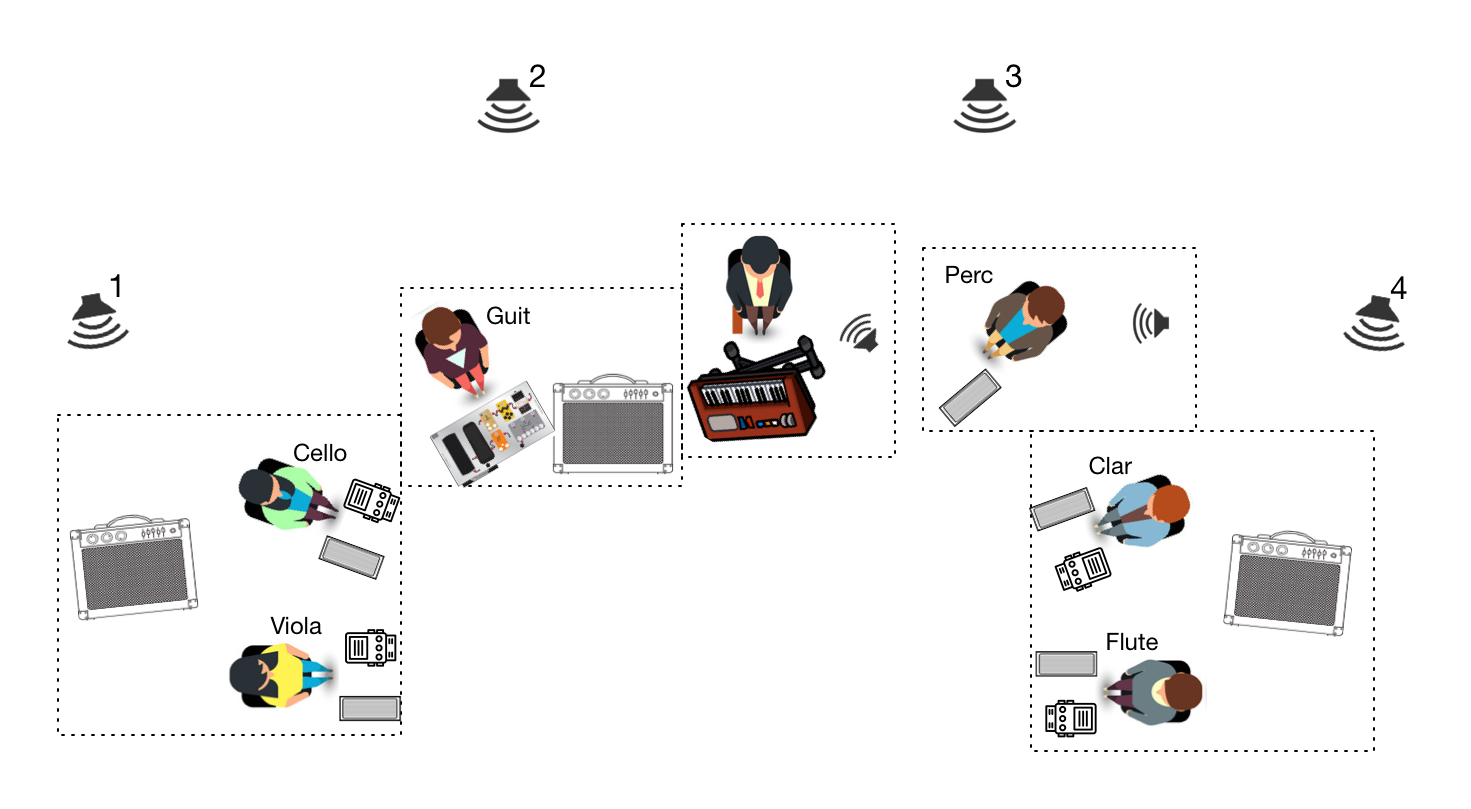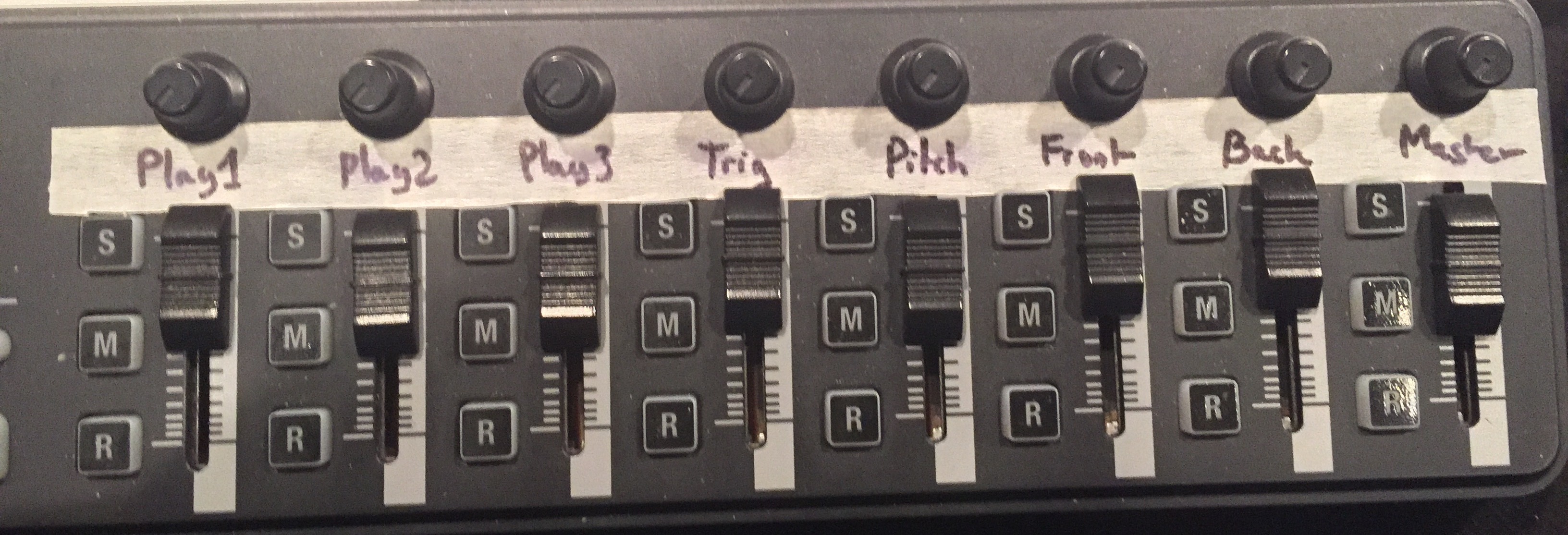Table of contents
Performance date: 9 mai 2019 - First performance
Documentation date: 18 mars 2020
Version state
Valid
Validation date: 2 mai 2020
Executions dates of this version
- 9 mai 2019,
Version documentalist
- blevy (Benjamin.Levy@ircam.fr)
Version realisation
- Benjamin Lévy (Computer Music Designer)
- Sylvain Cadars (Sound engineer)
- Damien Ripoll (Assistant)
Version length
30 mnNo other version available
Detailed staff
- flûte basse, clarinette basse, clavier électronique/MIDI/synthétiseur, percussionniste, guitare électrique, alto, violoncelle
Electronic equipment list
Computer Music Equipment
-
2 MacBook Pro - Apple Laptops
(Apple)
-
1 footswitch control - MIDI Controllers
(MIDI Solution)
-
2 MIDI Keyboard - MIDI Keyboard
-
1 Footswitch / Sustain Pedal - Footswitch / Sustain Pedal
-
1 Volume Pedal - Volume Pedal
-
1 MIDI booster - Booster
Audio Equipment
-
1 MKE 2-2R Blue Dot - Lavalier Microphones
(Sennheiser)
-
1 MKE 2-2R Red Dot - Lavalier Microphones
(Sennheiser)
-
1 MC1 - Contact Microphones
(FWF)
-
1 MV1 - Contact Microphones
(FWF)
-
6 DI-box - DI box
Musical Instruments
-
3 Little Big Muff Pi - Distortion Pedal
(Electro Harmonix)
-
3 Black Secret - Distortion Pedal
(Mooer)
-
3 Whammy 5 - harmonizer pedal
(Digitech)
-
3 Crybaby CB-535Q - Whawha pedal
(Dunlop)
-
2 Sentry - Noise Gate pedal
(T.C. electronic)
-
6 Pro RMP - Re-amping pedal
(Radial Engineering)
-
2 EV 5 - Expression pedal
(Roland)
-
2 OWL - Programmable pedal
(Rebel Technology)
Work related information
Premiere
- 9 mai 2019, Luxembourg, Philharmonie
Publisher :
- BabelScores
Realisation
- Benjamin Lévy
Work length
- 30 mn
Useful links on Brahms
- Mental Radio Machine I & II pour ensemble amplifié, pédales d'effet, sampler et électronique live (2019), 30mn
- Aurélio Edler-Copes
| File | Author(s) | Comment | |
|---|---|---|---|
| Download [807,2 Kio] | Technical rider Detailed Tech Rider | S.Cadars, B.Lévy, A.Edler-Copes | |
| Download [548,3 Mio] | Performance patch Patch & Sounds | A.Edler-Copes, B.Lévy | |
| Download [95,1 Kio] | Patch OWL Patches & Code | B.Lévy, A.Edler-Copes | |
| Download [6,5 Mio] | Score Full Score | A.Edler-Copes |
Instructions
Audio Setup
Pedals & Amp setup
4 groups of instruments have a effect pedals and guitar (Fender) amplifiers:
Viola and Cello have a common set of pedals, spread across both musicians and output in a guitar amplifier placed behind them.
Flute and Clarinet have also a common set of pedals, spread across both musicians and output in a guitar amplifier placed behind them.
Guitar has its own dedicated and custom pedalboard output in the amplifier in front of him and keyboards.
Cajon/percussions has a Whammy pedal only and is output in a dedicated monitor behind the player.
Audio setup
The audio routing and connexions are quite complicated in this piece as all the instruments have pickups going through the main mixer, then sent back to effect-pedals controlled by the musicians. Then the output of every pedal board is sent up to the mixer and back to the amplifiers on the stage. This means that a lot of DI-boxes and ReAmp-box are used to adapt levels and impedances to this circuit. The whole setup is best described by the diagram below:

Electronics & Loudspeaker setup
On the contrary, the electronic part setup is rather simple, the Max patch is sent to 4 channels, each of them being directly routed to 4 main speakers place behind the music ensemble to form an arch in the background as show in the diagram below.

Performance Patch
Software installation
The electronic part is solely composed of the Max patch and Sounds banks downloadable below. No specific external is necessary. The patch runs in Max 8 and no specific instruction is needed concerning vector/buffer sizes. A good habit is to run it with “Overdrive” option ON (but that’s not mandatory).
Patch presentation
The main patch of the piece is captured below.

The electronics has 3 main engines:
a triple file player used to play whole files triggered by the events and sometimes transpose and scratch by the keyboard player
a trigger sampler controlled and played note by note with one of the keyboards. This sampler assigns different files for different keys of the keyboard (starting from MIDI note
36). This sampler does not transpose files depending on the key pressed but depending on the expression pedal connected to the keyboard.a pitch sampler controlled and played note by note with the second keyboard. This sampler divides the keyboard in 2 sections (lower/upper half) and assignes one file to each section depending on the cue (event). For each section of the keyboard, the same file is played for every key pressed and transposed according to the MIDI pitch of the key.
Midi setup
There are several MIDI inputs and outputs in this piece. We used a sole iConnect interface to gather all of them and interface them with Max/MSP. The configuration of those is done in the right column of the main patch captured above.
Inputs
A sustain/footswitch pedal connected to one of the keyboards and received as MIDI controller
64is used to trigger the next event of the piece. You can turn it off or change the “polarity” of the pedal with the small menu on the line labeledPEDAL. The smallbangnext to it is only used for visualization of the incoming pedal hits.The large MIDI keyboard on stage is routed to the pitch sampler.
The small MIDI keyboard on stage is routed to the trigger sampler. Those two keyboards can be played on the same MIDI input/connection if they are assigned to two different channels.
An expression pedal connected to one of the keyboards and received as MIDI controller
11is used to transpose either the trigger sampler or the file players depending on the cues.The modulation ring (pitchmod) of one of the keyboards is received as MIDI controller
1directly in the players patch (objectctlin 1)Finally, you can chose a MIDI controller as a nanoKontrol2 or a BCF2000 connected to the computer and acting as
MIDI MIXER. Below is a picture of the nanoKontrol routing used for this performance of the piece.

Outputs
The Max patch of this piece is used to send control signals to the 4 Whammy pedals on stage, changing their mode depending on the cues (event) of the piece. These info are sent as MIDI Progam Change messages dispatched to each of the Whammies depending on the MIDI channel (1to4). In the menu at the bottom of the right column of the patch, you need to chose the correct MIDI device connected to your computer and going on stage to be split and connected to the 4 pedals.
Manual controls
Init / Stop / Reset / Panic
The bangs on the top of the patch are used to initialize, stop the playing of files, reset the state of the patch (in particular when rehearsing) and stop everything in case of emergency
key shortcuts
esckey is mapped to reset the patch (same àresetbutton).leftandrightarrows are mapped to go forward or backward for thenext event.if the
KEYcheckbox is ticked next theNEXT EVENTlabel in the main patch, then you can use thespacebarto effectively trigger the next event.
Starting
There are not actions needed after loading the patch to start playing the piece. The init button is loadbanged automatically and turns also the DSP of Max ON. However, be sure that your MIDI inputs and outputs are correct!
OWL Pedal
This piece uses a programmable OWL pedal from the firm Rebel Technologies. We designed for this piece a specific digital distorsion effect based on sampling rate reduction and sample depth reduction (bit crushing). The design of those engines have be made in Max/MSP with the use of gen~ object which allows to compile and embed the resulting effect into the OWL pedal.
gen~ patches
In the archive named OWL Patches & Code above, you will find all the element to examine, modify and compile (if needed) the digital distorsion (named digisto). These are Max and gen~ patches as well as the corresponding exported C++ code and a sysex export of the effect as we used it.
Note: the OWL parameters are to be used in gen~ with parameter names: A, B, C, D, Exp, and Push.
sysex file
You can upload the syx file (MIDI sysex export) directly to the OWL without needing to recompile anything. For that operation, you need download and use the application OwlControl found on this website: https://github.com/pingdynasty/OwlControl
Load the syx file with the Tools/Load file from patch menu of the application. Choose either to run or to store the patch in one of the 4 custom slot of the pedal. Then upload to the pedal with the Save to OWL button of the interface. You should be able to test the digital distorsion directly on the pedal, without connecting it to a computer.
Knobs & buttons
As any guitar pedal, the main metal switch is use to engage or bypass the effect.
The top left knob is a
Drivecontrol. It thus controls the intensity of the effect from no effect at all to full distorsion.Second to left knob is a
Mixcontrol balancing from left to right between the decimation (sample rate reduction) and the bit crusher (sample depth reduction) effect. In the middle, both effects are active and mixed together.The third knob is a
Tonecontrol which changes the center frequency of bandpass filter integrated at the end of the effect chain.The most right knob is a
levelcontrol which allows you to set the output volume of the pedal
Toolchain & Compilation
If you wish to compile yourself the Max/gen~ patch to modify it and upload it to the OWL pedal, you will need to gather those 3 tools:
the OWL program containing the whole architecure of folders and scripts aso. to compile for the pedal
gcc arm compiler (to make patch binary) to be placed in the
Toolsfolder of the OwlProgram [1]FirmwareSender (to make sysex and run) to be placed in the
Toolsfolder of the OwlProgram as well [2]
Building a Max gen~ patch, upload and run on the OWL pedal
To build and compile a Max/gen~ you need to export the code from the patch with the exportcode message. This creates a .cpp and a .h files as well as a gen_dsp folder in a code folder alongside your patch.
Then, you shoud be able to compile and run a patch called digisto with those steps:
copy
digisto.cpp,digisto.handgen_dspfolder intoPatchSourceof the OwlProgramin the terminal
cdto your toolchain/OwlProgram directorythen execute
make GEN=digisto runto compile and upload patch to attached OWL
Sysex export of a Max gen~ patch
Requires the .cpp and .h files of a gen~ patch generated by Max.
Then to compile and create a sysex file of a gen~ patch called digisto:
copy
digisto.cpp,digisto.handgen_dspfolder intoPatchSourcein the terminal
cdto your toolchain/OwlProgram directorythen execute
make GEN=digisto sysexto compile and package binary as sysex
References
[1] https://developer.arm.com/open-source/gnu-toolchain/gnu-rm
© IRCAM

This documentation is licensed under a Creative Commons Attribution-NonCommercial-NoDerivatives 4.0 International License.
Program note
Dans Mental Radio Machine, Aurélio Edler-Copes thématise les paradoxes de la révolution numérique. Il entame une réflexion sur l’utilisation croissante de systèmes technologiques dans notre société ainsi que sur le rapport entre l’homme et la machine. Son univers se situe au point de bascule entre l’émerveillement envers les nouvelles technologies et l’effroi face à leurs dérives.
L’effectif réunit des instruments acoustiques (flûte basse, clarinette basse, alto, violoncelle et percussion), une guitare électrique et des samplers. Tous les instruments sont connectés à des amplificateurs à lampe et traités avec des pédales d’effet analogiques ainsi qu’avec une nouvelle génération de pédales open source. Ces dernières permettent de concevoir et d’intégrer des patches Max dans la chaîne de pédales des musiciens sur scène, sans passer par l’ordinateur. Une vraie fusion entre l’analogique et le numérique ! Par ailleurs, un multi-échantillonneur, conçu spécifiquement pour la pièce, permet de déclencher et de manipuler en temps réel une voix de synthèse lo-fi. Cette voix, spatialisée en quatre canaux sur scène, est en constant dialogue avec l’ensemble, créant ainsi une étrange symbiose entre voix synthétique et geste instrumental. Un corps sonore hybride, vocal et instrumental, analogique et numérique, électroacoustique et synthétique.
À la source de cette œuvre électrique se trouvent le flux textuel des derniers romans de Thomas Bernhard — leurs discours incessants, frénétiques et répétitifs, tel une voix off dans la tête du lecteur — ainsi que des symboles de la culture pop des années 1980 (ordinateurs personnels, jeux vidéo, robots, vocodeurs, radiocassettes) et certaines des technologies actuelles (reconnaissance facial, vidéo surveillance, intelligence artificielle).
Aurelio Edler-Copes, note de programme du concert du 10 septembre 2020 au T2G - Théâtre de Gennevilliers.
Version documentation creation date: 18 mars 2020 17:27, update date: 6 mai 2021 15:09